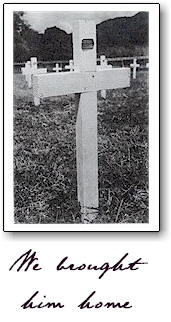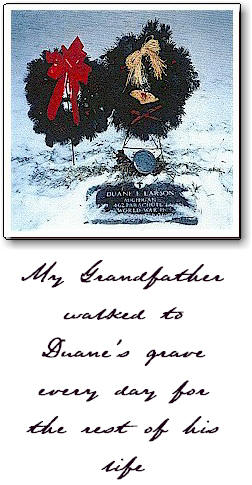
|
 |
|
"DUANE
LARSON - THE PRESENCE OF HIS ABSENCE"
|
When
my nine year old father, Duane Larson, appeared in the middle of the morning
with the news that Sister had sent him home - and not because he was ill -, his
little brother Keith gleefully anticipated mother and son fireworks. Even though
the baby of my |
|
Perhaps my father and his siblings did not know that the St. Joseph River was one of only two rivers in the world to flow north; what they did know was that it provided free food and fun year round. What boy could be bored when he could be swimming, fishing, boating, ice skating, or just messing around in the woods like Huck Finn? �I dare you!� �I double dare you!�
My father worked for a time at the Niles News Agency, but like so many small town boys he was restless and rode his Harley Davidson to California to see what was on other side of the mountains. By October of 1941 he had joined the 19th Coast Artillery. His early swimming feats stood him in good stead and he was able to save a man�s life by pulling him from the riptide off the California coast. Then came Pearl Harbor and the Army. Jump school for paratroopers was a four week course at Fort Benning, GA.
On
March 29, 1944, the 462nd debarked at Brett�s wharf, Brisbane, and joined the
503 PIR at Camp Cable, a tent army encampment within walking distance of a small
town named Beaudesert (which the Aussies pronounced Bydesert, though there was
no desert nearby).
Training continued with marches and jumps and although the men did not consider it overly strenuous they did feel they were gaining valuable experience. By September of 1944, the 503rd Parachute Infantry Regiment, the 462nd parachute Artillery Battalion and the 161st Parachute Engineer Company had formed the Regimental Combat Team. On September 16, 1944, the 462nd landed at Noemfoor Island, Netherlands East Indies. Airfields constructed on Noemfoor after its capture played an important role in the Allied advance from New Guinea to the Philippines. On October 23, Major Arlis Kline assumed command of the battalion. On November 9th the battery left on the U.S.S. Custer and arrived on Leyte Island on November 18th. Two Regimental Combat Teams, the 19th and the 503rd, were given the mission of seizing and holding the southwestern part of Mindoro Island near the town of San Jose so that three airstrips could be constructed. The Combat Team endured intense air and naval fire and at one point was shelled for 25 minutes by a Japanese Naval task force. In January my father had written that the Japanese had �one good fight left in them� ; soon the war would be over and he would be coming home. And then came Corregidor. Tokyo had warned the Japanese commander, Itagaki, to be prepared for an airborne landing, but Itagaki had studied the terrain and judged an airborne landing �not doable.� On February 16, 1945, he was looking out to sea at the 34th Infantry�s 3rd Battalion landing barges and never noticed the white blossoming C-47�s until some 25 to 30 paratroopers, blown off course, landed practically on top of him. The troopers formed up and fired, killing Itagaki and eight others around him. The Japanese lost their commander before the fighting had really begun.
Over
on Jump Zone A, Arlis Kline, the
commander of Duane's element within the Rock Force, was seriously hit by an unidentified piece of flying steel whilst still in the
air , rendering him unable to control his chute as he plummeted towards the
houses along officer's row. Barely missing becoming impaled on a jagged
tree trunk, and with serious leg injuries, he hung in the tree, but with
his feet touching the ground, unable to release himself from his parachute
harness as he was unable to put any weight upon his feet. For some
indefinable time, he lapsed in and out of consciousness. PFC
Joe Vela, Kline's orderly, who had followed Kline out of the aircraft, cut
him down. After the second drop, his deputy commander Maj. Melvin
Knudson, together with Vela, helped him to the 462nd command post, where
he spent the next few days "talking on the field phones, in between coughing up blood." My father landed safely but he had only ten more days to live. James Wilcox described for me what the landing was like for his gun section in Battery A: �Your father, whom I called Larson, and Brayton, his best friend, were the finest paratroopers and the backbone of our section. A section is one 75 MM Pack Howitzer and a crew of about ten men. The Pack Howitzer was designed to be the artillery piece of the mountain soldiers who used mules to carry the gun pieces. The advantage of this weapon was that it could be broken down into several pieces, nine in all, each weighing around 200 lbs. When the Airborne arrived on the ground at the drop zone, there were no jeeps or trucks or mules to handle the movement, so we paratroopers furnished the motive power. It was very hard physical labor, but we were young and were in competition with the other sections of our Battery to see who was best. �...We were most fortunate in our jump. Our equipment landed in the exact center of our drop zone... . The net result was that our section had its gun assembled and at our rendezvous point HOURS before the next section arrived. The other two sections had been jumped off the top of the island, some even into the sea, and didn�t get there at all. I�m telling you this so that you will know what kind of soldier your dad was. �Larson was about six feet, fair complexion, light hair and medium weight,... a nice looking man. He was courteous, well-mannered and mature. Brayton was also like that, which was perhaps why they were buddies. He ... was always a pleasure to be around because of his decency, maturity, and reliability.� By February 26, the men had reached the tail of the tadpole at Monkey Point and were �mopping up.� Already General MacArthur was making plans for his return to Corregidor. Just northeast was a little ridge and under it was an underground network of tunnels which had housed the Navy�s Radio Intercept Station. Unknown to the men on Monkey Point, the Japanese had packed the caves under the ridge with explosives. Battery A of the 462nd had moved along the shore road just past the tunnel entrances; two tanks were helping the soldiers close these entrances off. At ll:05 one of the tanks fired into the sloping entrance of the Monkey Point tunnel. Simultaneously, a violent explosion lifted the top off the ridge over the Radio Intercept Station. Both 35 ton tanks flew into the air and tumbled end over end down the ridge. Bodies were lifted high and rained down again in pieces. A chunk of debris landed on a destroyer over a mile away. The little ridge was now only a hole in the ground. Sergeant Eugene Bert found himself down in the valley and couldn�t remember how he got there. When he scrambled back up to the top of Monkey Point, the first sight that met his eyes was my father crushed under a huge boulder. Sergeant Bert feels that my father must have died instantly and did not suffer as many did before they died. My father, his best friend Lawrence Brayton and the rest of the dead were wrapped in ponchos; the line of bodies along the road extended over 100 feet.
On February 21, 1949, when a military escort accompanied him back to Niles, his life had come full circle. In St. Mary�s he had been baptized and from St. Mary�s he was taken to Calvary Cemetery to be buried . My Grandfather walked to Duane's grave every day for the rest of his life.
Although �the presence of his absence� has been with me all my life, it is thanks to American War Orphan's Network that I was able to get in touch with those who knew him. Recently Arlis Kline returned to Corregidor. He attempted to take a picture of Monkey Point for me, but �the jungle is so thick that it is impossible to even be sure where the hole, �a huge oblong crater 130 feet long, 70 feet wide, and 30 feet deep,� [Belote, 253] that resulted from the explosion is located.� The jungle has healed itself with time and so have the wounds in our hearts. They can be made to bleed again, though, when we see that our fathers� sacrifices are taken for granted, when we see our flag treated with disrespect, when we see our national anthem mocked. Even though our fathers never saw us nor were even on the same continent as we were, �for one brief shining moment� in time, our fathers and mothers and we children were a family. Now it is up to us, the AWON children, to see that the legacy of the greatest generation is not forgotten. Dolane Larson
|
|
|
|
|
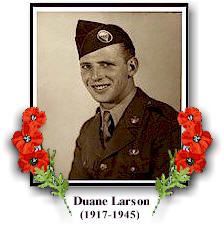
 �Now
you�re really in trouble!�
�Now
you�re really in trouble!�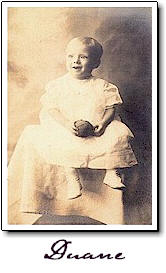 father�s family is now eighty years old, he retains the look of
a (albeit large) cherub: his pale blonde hair is mostly gray but his blue eyes
can still fill up with mischief when he remembers that long ago day. Keith had,
however, seriously underestimated his mother�s maternal instincts. Anna Larson
quickly wiped her hands on her apron and, with her son Duane in tow, headed
straight for St. Mary�s School. When she came back an hour later after a
confrontation that spread from Sister to Superior to parish priest, both mother
and son had been �expelled� from St. Mary�s. Although they were later
readmitted to the parish (when St. Mary�s received a new pastor), my father
finished his education in public school.
father�s family is now eighty years old, he retains the look of
a (albeit large) cherub: his pale blonde hair is mostly gray but his blue eyes
can still fill up with mischief when he remembers that long ago day. Keith had,
however, seriously underestimated his mother�s maternal instincts. Anna Larson
quickly wiped her hands on her apron and, with her son Duane in tow, headed
straight for St. Mary�s School. When she came back an hour later after a
confrontation that spread from Sister to Superior to parish priest, both mother
and son had been �expelled� from St. Mary�s. Although they were later
readmitted to the parish (when St. Mary�s received a new pastor), my father
finished his education in public school.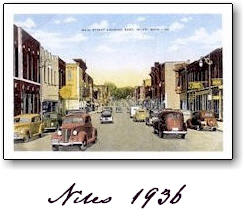 Duane
Larson was born on May 17, 1917, in Niles, a small southwestern Michigan town
founded in 1829. Called the City of Four Flags because the flags of Spain,
France, England and the United States had flown over Fort St. Joseph, Niles was,
even during the Depression, an idyllic place to grow up.
Duane
Larson was born on May 17, 1917, in Niles, a small southwestern Michigan town
founded in 1829. Called the City of Four Flags because the flags of Spain,
France, England and the United States had flown over Fort St. Joseph, Niles was,
even during the Depression, an idyllic place to grow up. Clambering
up the ladder of a boxcar stopped on a high stone bridge and then diving off
from its roof into the swiftly moving currents of the St. Joe River took a
certain amount of nerve. Maybe my father chose to be a paratrooper because when
he was a boy he grew to like the wind in his face as he jumped from the boxcars
into the dark waters of the current furrowed river.
Clambering
up the ladder of a boxcar stopped on a high stone bridge and then diving off
from its roof into the swiftly moving currents of the St. Joe River took a
certain amount of nerve. Maybe my father chose to be a paratrooper because when
he was a boy he grew to like the wind in his face as he jumped from the boxcars
into the dark waters of the current furrowed river.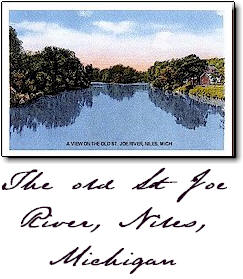
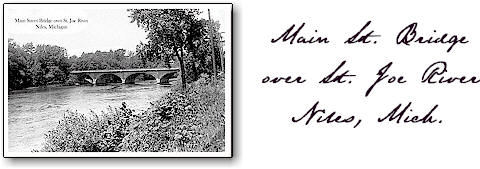
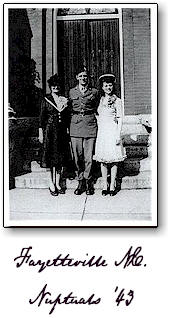
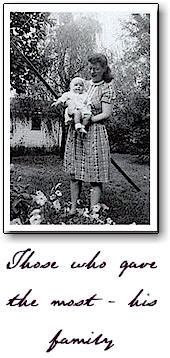
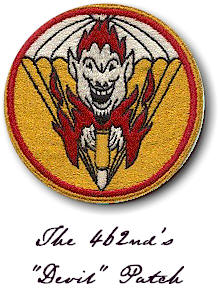 �The
men who floated down over Corregidor on that sparkling morning of February 16,
1945, represented not only a new way of warfare, but also a new breed of
American soldier, the paratrooper. This was the sort of soldier who had brought
a new dimension to attack.� [Belote, 225] The �tough and aggressive�
paratroopers knew that the Corregidor jump was not going to be a picnic. They
were to jump onto �the worst jump field ever used for an airborne operation�
from the dangerously low altitude of 400 feet.
�The
men who floated down over Corregidor on that sparkling morning of February 16,
1945, represented not only a new way of warfare, but also a new breed of
American soldier, the paratrooper. This was the sort of soldier who had brought
a new dimension to attack.� [Belote, 225] The �tough and aggressive�
paratroopers knew that the Corregidor jump was not going to be a picnic. They
were to jump onto �the worst jump field ever used for an airborne operation�
from the dangerously low altitude of 400 feet.
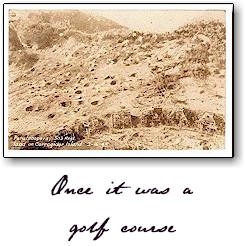
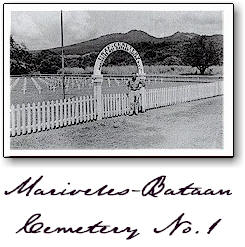 On
Jan. 14, 1945, my father had written to relatives, "I hope to see Don in
the near future. He should be coming to the Philippines soon and maybe we can
get together." By the time Don arrived, my father was dead, and all
that Don could do was take a picture of the cemetery and of his brother's grave.
My
father�s body remained in the Philippines until after the war.
On
Jan. 14, 1945, my father had written to relatives, "I hope to see Don in
the near future. He should be coming to the Philippines soon and maybe we can
get together." By the time Don arrived, my father was dead, and all
that Don could do was take a picture of the cemetery and of his brother's grave.
My
father�s body remained in the Philippines until after the war. 